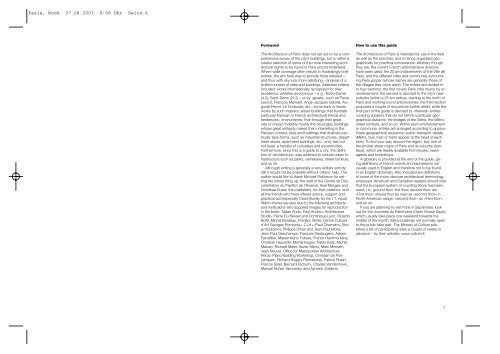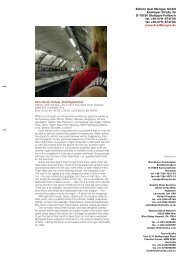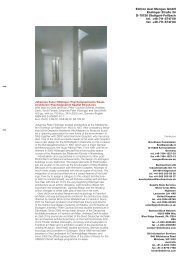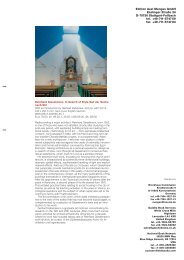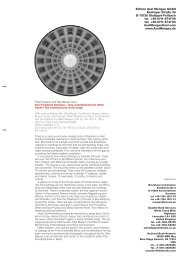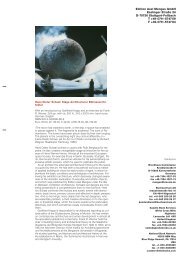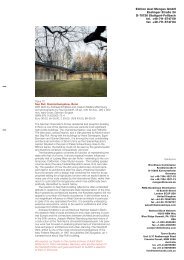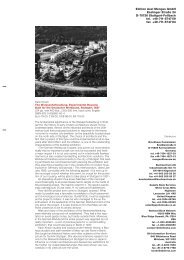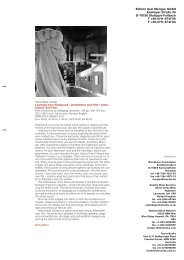Edition Axel Menges GmbH Esslinger Straße 24 D-70736 Stuttgart ...
Edition Axel Menges GmbH Esslinger Straße 24 D-70736 Stuttgart ...
Edition Axel Menges GmbH Esslinger Straße 24 D-70736 Stuttgart ...
Create successful ePaper yourself
Turn your PDF publications into a flip-book with our unique Google optimized e-Paper software.
Paris, book 27.08.2003 9:08 Uhr Seite 6<br />
Foreword<br />
The Architecture of Paris does not set out to be a comprehensive<br />
survey of the city’s buildings, but is rather a<br />
careful selection of some of the more interesting architectural<br />
sights to be found in Paris and its hinterland.<br />
Where wide coverage often results in frustratingly brief<br />
entries, the aim here was to provide more detailed –<br />
and thus with any luck more satisfying – analysis of a<br />
limited number of sites and buildings. Selection criteria<br />
included: works internationally recognized for their<br />
excellence, whether anonymous – e.g., Notre-Dame<br />
(4.2), Saint-Denis (21.2) – or by »greats« such as Pierre<br />
Lescot, François Mansart, Ange-Jacques Gabriel, Auguste<br />
Perret, Le Corbusier, etc.; some early or lesser<br />
works by such masters; lesser buildings that illustrate<br />
particular Parisian or French architectural trends and<br />
tendencies; »monuments« that through their great<br />
size or impact indelibly modify the cityscape; buildings<br />
whose great antiquity makes them interesting in the<br />
Parisian context; sites and buildings that illustrate particular<br />
type-forms, such as industrial structures, department<br />
stores, apartment buildings, etc.; and, last but<br />
not least, a handful of curiosities and eccentricities.<br />
Furthermore, since this is a guide to a city, the definition<br />
of »architecture« was widened to include urban infrastructure<br />
such as parks, cemeteries, street furniture,<br />
and so on.<br />
Although writing is generally a very solitary activity,<br />
still it would not be possible without others’ help. The<br />
author would like to thank Michael Robinson for setting<br />
the whole thing up, the staff of the Centre de Documentation<br />
du Pavillon de l’Arsenal, <strong>Axel</strong> <strong>Menges</strong> and<br />
Dorothea Duwe, the publishers, for their patience, and<br />
all the friends who have offered advice, support and<br />
practical aid (especially David Bundy for his I.T. input).<br />
Warm thanks are also due to the following architects<br />
and institutions who supplied images for reproduction<br />
in the book: Tadao Ando, Paul Andreu, Architecture<br />
Studio, Pierre Du Besset and Dominique Lyon, Ricardo<br />
Bofill, Michel Bordeau, Frédéric Borel, Centre Culturel<br />
d’Art Georges Pompidou, C+H+ (Paul Chemetov, Borja<br />
Huidobro), Philippe Chaix and Jean-Paul Morel,<br />
Jean-Paul Deschamps, François Deslaugiers, Adrien<br />
Fainsilber, Massimiliano Fuksas, Franck Hammoutène,<br />
Christian Hauvette, Michel Kagan, Pablo Katz, Michel<br />
Macary, Richard Meier, Xavier Menu, Marc Mimram,<br />
Jean Nouvel, Office for Metropolitan Architecture,<br />
Renzo Piano Building Workshop, Christian de Portzamparc,<br />
Richard Rogers Partnership, Patrick Rubin,<br />
Francis Soler, Bernard Tschumi, Charles Vandenhove,<br />
Manuel Nuñez Yanowsky, and Aymeric Zublena.<br />
How to use this guide<br />
The Architecture of Paris is intended for use in the field<br />
as well as the armchair, and is hence organized geographically<br />
for practical convenience. Arbitrary though<br />
they are, the current French administrative divisions<br />
have been used: the 20 arrondissements of the Ville de<br />
Paris, and the different villes and communes surrounding<br />
Paris proper (whose names are generally those of<br />
the villages they once were). The entries are divided into<br />
four sections: the first covers Paris intra muros by arrondissement;<br />
the second is devoted to the city’s near<br />
suburbs (within a 25 km radius), starting to the north of<br />
Paris and working round anticlockwise; the third section<br />
proposes a couple of excursions further afield; while the<br />
final part of the guide is devoted to »themed« entries<br />
covering subjects that do not fall into particular geographical<br />
divisions: the bridges of the Seine, the Métro,<br />
street furniture, and so on. Within each arrondissement<br />
or commune, entries are arranged according to approximate<br />
geographical sequence; public-transport details<br />
(Métro, bus, train or tram) appear at the head of each<br />
entry. To find your way around the region, buy one of<br />
the pocket street maps of Paris and its suburbs (banlieue),<br />
which are readily available from kiosks, newsagents<br />
and bookshops.<br />
A glossary is provided at the end of the guide, giving<br />
definitions of French words and expressions not<br />
usually used in English and therefore not to be found<br />
in an English dictionary. Also included are definitions<br />
of some of the more obscure architectural terminology<br />
employed. American and Canadian readers should note<br />
that the European system of counting floors has been<br />
used, i.e., ground floor, first floor, second floor, etc.<br />
»First floor« should thus be read as »second floor« in<br />
North-American usage, »second floor« as »third floor«,<br />
and so on.<br />
If you are planning to visit Paris in September, look<br />
out for the Journées du Patrimoine (Open House Days),<br />
which usually take place one weekend towards the<br />
middle of the month. Many buildings not normally open<br />
to the public take part. The Ministry of Culture publishes<br />
a list of participating sites a couple of weeks in<br />
advance – try their website, www.culture.fr.<br />
7


